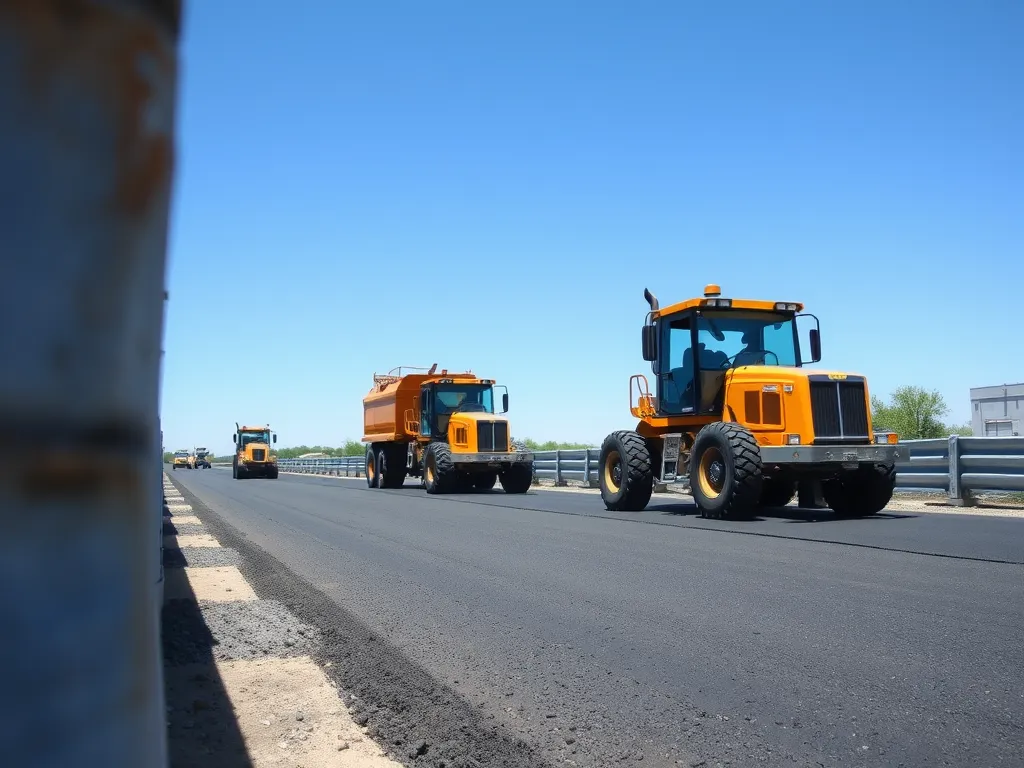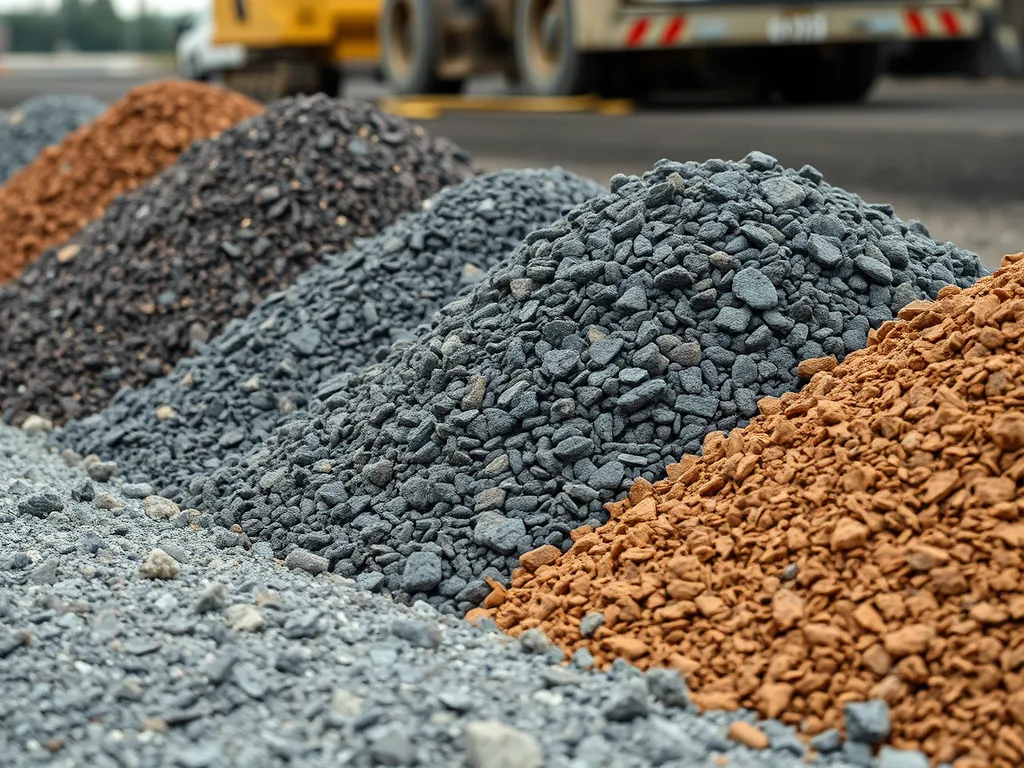Common Mistakes in Asphalt Calculations and How to Avoid Them
Published on: October 23, 2025 | Last Updated: April 14, 2025
Written By: George Voss
Common mistakes in asphalt calculations—like mismeasuring areas or ignoring compaction ratios—lead to budget overruns, delayed projects, and wasted materials. Errors often stem from overlooking asphalt density (145-150 lbs per cubic foot), terrain slopes, or mix design specifications. Fixing these issues requires precise measurements, standardized units, and factoring in real-world variables like temperature changes.
This guide covers seven critical asphalt calculation errors and step-by-step solutions. You’ll learn how to avoid surface measurement blunders, adjust for 20-30% compaction loss, and handle slopes or drainage needs. We’ll also explain unit conversion traps, why adding 5-10% waste buffers matters, and how local climate impacts PG (performance-graded) binder choices. Get ready to tackle your next project with confidence.
Contents
The Importance Of Accurate Asphalt Calculations
Precision in asphalt math directly affects project success. Even small errors in volume, weight, or mix ratios create chain reactions. Let’s break down why getting these numbers right matters.
Cost Implications Of Asphalt Quantity Miscalculations
Ordering 10% extra asphalt adds $1,500+ to costs for a standard driveway. Underestimating leaves crews idle while waiting for more material—racking up labor fees at $75-$120/hour. Tonnage errors also trigger pricey adjustments: PG 64-22 binder costs $600-$800 per ton, while aggregates run $12-$18 per ton. Using tools like the asphalt quantity calculator with built-in density tables (145-155 lbs per cubic foot) prevents budget blowouts.
Impact on Project Timelines and Material Waste
Wrong asphalt calculations delay schedules. A 2-day pour stretched to 4 days risks weather setbacks. Excess material becomes waste—up to 8% of asphalt ends up unused due to asphalt estimation mistakes. Improper compaction from rushed fixes lowers pavement density below 92% (per Superpave standards), cutting lifespan by years. Recycling helps but costs $20-$30 per ton for reprocessing.
Mastering these calculations requires tackling specific errors head-on. Let’s explore the most frequent slip-ups—and proven fixes—next.
Common Asphalt Calculation Errors and How to Avoid Them
Even minor asphalt quantity miscalculations can derail projects. Let’s break down frequent errors and actionable fixes.
Incorrect Surface Area Measurements
Assuming rectangular shapes or flat surfaces leads to asphalt amount inaccuracies. Irregular layouts like kidney-shaped driveways or trapezoidal parking lots require precise geometry.
Solution: Employ Precise Surveying Tools and Account for Irregular Shapes
Laser scanners or GPS mapping tools capture exact dimensions. For curved edges, apply the trapezoidal rule or CAD software. Add 3-5% extra material for jagged perimeters.
Ignoring Compaction Ratios
Fresh asphalt loses 20-25% volume during compaction. Skipping this adjustment causes shortages.
Impact of Inadequate Compaction on Asphalt Density
Low compaction reduces density below 92% of maximum theoretical density (ASTM D2041). This weakens pavement, increasing rutting risks under loads exceeding 40 kN per axle.
Neglecting Slopes, Curves, and Drainage Requirements
Steep slopes (≥2%) or concave surfaces demand thicker layers. Drainage trenches also alter volume needs.
Adjusting Calculations for Complex Terrain and Water Runoff
Multiply area by slope factor (1.02–1.15 based on grade). For French drains or swales, add 0.15–0.3 tons per linear foot.
Unit Conversion and Measurement Inconsistencies
Mixing metric tons (1,000 kg) with short tons (907 kg) creates asphalt tonnage calculation errors. Temperature-based volume shifts (1.5% per 10°F change) compound this.
Standardizing Units Across All Project Phases
Lock units early: choose either imperial (tons, square feet) or metric (tonnes, square meters). Verify batch plant tickets match project specs.
Underestimating Material Waste and Yield Loss
Spillage, over-excavation, or uneven spreading can waste 7-12% of asphalt.
Adding Buffer Percentages for Realistic Quantity Estimates
Include a 8-10% buffer for small projects (<10 tons) or 5-7% for large-scale jobs. Track historical waste rates from past work.
Miscalculating Asphalt Mix Ratios
Selecting PG 58-28 binder instead of PG 76-16 for high-traffic zones compromises stability.
Verifying Mix Design Specifications Before Calculation
Cross-reference job specs with mix design reports. Confirm aggregate gradation (e.g., ¾” crushed stone vs. ½” recycled) and binder content (5.5–6.5% by weight).
Overlooking Project-specific Requirements
Municipal codes may mandate thicker bases (6” vs. 4”) or higher R-values (≥78 psi) for arterial roads.
Reviewing Local Standards and Load-Bearing Needs
Check AASHTO M323 or regional DOT guidelines. For heavy truck traffic (ESALs >10 million), specify high-modulus asphalt concrete (HMAC).
Precision in calculations prevents cost overruns, but pavement longevity also depends on external stressors. Next, we examine how environmental and operational factors degrade asphalt over time.

Factors Leading to Asphalt Damage and Degradation
Flaws in asphalt math speed up wear and tear. Small errors in depth, mix, or load plans create weak spots. Spot these risks early to boost pavement life.
Weather Exposure and Thermal Stress
Wrong temp data cracks surfaces. Asphalt swells in heat and shrinks in cold. If your math ignores local climate swings, gaps form. Use PG binders (performance-graded oils) that match regional highs and lows. Add 2-3% extra mix for thermal gaps in zones with 50°F+ annual shifts.
Heavy Traffic Loads and Fatigue Cracking
Low traffic counts cause thin mats. A single 18-wheeler does as much harm as 10,000 cars. Missing ESALs (truck load metrics) in your counts leads to cracks. For roads with 500+ trucks daily, raise mat depth by 1.5 inches. Mix in 5-6% polymer for flex.
Poor Installation Practices Affecting Longevity
Bad roller math ruins density. If you skip the 3-pass rule for compaction, air pockets remain. Each 1% drop below 92% density cuts lifespan by 10%. Track roller GPS logs to confirm full coverage. Test cores post-install to verify specs.
Chemical Exposure and Surface Erosion
Wrong mix picks decay fast. Fuel spills and road salts strip binders. If your plan lacks seal coats or lime adds, surfaces crumble. For lots with fuel traffic, use PG 76-22 binders. Budget 0.25 gallons per sq yd of sealer every 3 years.
These factors show how asphalt math ties to real-world risks. Next, we’ll see how green choices shape mix plans.
Also See: Dos and Don’ts Of Using an Asphalt Infrared Heater
Environmental Considerations in Asphalt Calculations
Overlooking environmental factors ranks among the most frequent asphalt quantity miscalculations. Temperature shifts and sustainability requirements directly impact material behavior and project specs. Ignoring these elements leads to asphalt weight miscalculations, premature failures, or regulatory penalties.
Accounting for Temperature Effects on Material Expansion
Asphalt expands by 0.000018 inches per degree Fahrenheit for every inch of material. A 30°F temperature swing in a 1,000-foot road section creates 6.48 inches of linear expansion. Failing to apply thermal adjustment formulas like ΔL = αLΔT causes buckling or cracks. Always factor in local climate data and PG binder grades during mix design. Advanced software tools now auto-calculate expansion gaps using real-time weather forecasts.
Sustainable Practices to Minimize Environmental Impact
Using 30% Recycled Asphalt Pavement (RAP) slashes costs by $8-$15 per ton but requires precise mix recalibrations. Permeable asphalt installations need 25% thicker bases for stormwater management – a common source of asphalt amount inaccuracies. New EPA guidelines mandate tracking carbon footprints per ton of laid asphalt. Contractors missing these specs face 5-10% bid disqualifications in federal projects. Cross-check sustainable material ratios against ASTM D8 standards before finalizing quantities.
Mastering these environmental variables prevents costly asphalt tonnage calculation errors. Next, we’ll examine how structural demands influence measurement precision.

Frequently Asked Questions (FAQs)
What Damages Asphalt the Most?
Asphalt is most significantly damaged by a combination of weather exposure, heavy traffic loads, poor installation practices, and chemical exposures. These factors can cause surface deterioration, cracking, and decreased lifespan. To mitigate damage, it’s crucial to utilize proper materials, adhere to installation best practices, and conduct regular maintenance.
What Happens if Asphalt is Not Compacted Enough?
If asphalt is not compacted adequately, it can result in reduced density, which weakens the pavement structure and makes it susceptible to deformation, cracking, and ruts under heavy loads. Insufficient compaction can decrease the overall lifespan of the asphalt surface and lead to costly repairs. Proper compaction techniques, such as following the recommended rolling patterns and moisture content checks, are essential to ensure pavement longevity.
How Can Poor Weather Conditions Affect Asphalt Calculations?
Poor weather conditions can lead to miscalculations in asphalt mix design and application. For instance, temperature changes can affect the viscosity of asphalt, and lack of precipitation may lead to increased evaporation of volatile components, altering the mix’s properties. It’s important to use performance-graded binders that correspond with local climate to ensure the asphalt performs well under varying conditions.
What Should Be Considered When Estimating Asphalt Thickness?
When estimating asphalt thickness, factors such as expected traffic loads, soil conditions, and the intended use of the pavement should be taken into account. Higher traffic volumes necessitate thicker layers to withstand stress, while unstable soil may require additional base preparation to avoid settling. A combination of local regulations and engineering specifications should guide the thickness decisions to ensure stability and performance.
How Can Accurate Measurements Prevent Waste in Asphalt Projects?
Accurate measurements can significantly reduce waste in asphalt projects by ensuring that the right amount of material is ordered and applied. Utilizing precise surveying tools and accounting for all project specifics—like slopes and drainage—helps to create a more effective paving plan. By incorporating buffer percentages to cover potential waste and measuring accurately, contractors can minimize excess material and costs, ultimately leading to a more efficient project.
What Role Does the Choice Of Asphalt Mix Play in Project Success?
The choice of asphalt mix plays a crucial role in project success as it affects the longevity, durability, and performance of the pavement. Selecting the appropriate mix based on traffic volume, climate, and application type ensures that the asphalt can withstand environmental stressors and loads. Thoroughly reviewing mix design specifications helps to avoid costly mistakes and ensure that the pavement meets required standards.

Closing Thoughts
Accurately calculating asphalt requirements is vital to any successful paving project. Mistakes in measurement, compaction, or material ratios can lead to increased costs and project delays. Understanding common pitfalls and implementing effective solutions ensures that your asphalt work stands the test of time.
Stay informed and equipped with the right tools to navigate the complexities of asphalt calculations. For more resources and information, be sure to check out Asphalt Calculator USA.
Additional Resources for You:
- Kett, I. (1999). Asphalt Materials and Mix Design Manual. Oxford: Elsevier Science.
- 5 Common Mistakes to Avoid When Installing an Asphalt Driveway | Buck Bros
- Don’t Be At Fault: 7 Common Asphalt Paving Mistakes To Look Out For and Avoid – Perrin Construction
- Asphalt Calculator – Calculate Your Asphalt Requirements
- Common Mistakes in Asphalt Paving and How to Avoid Them


